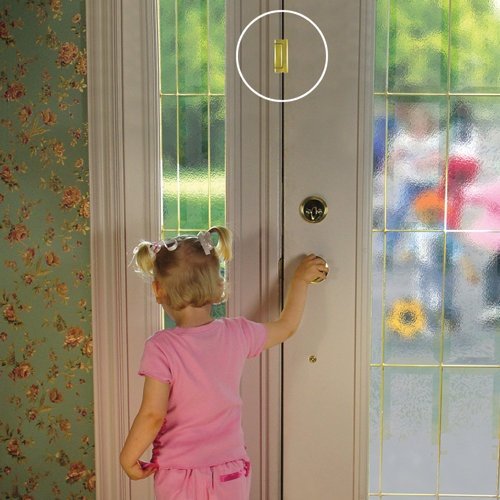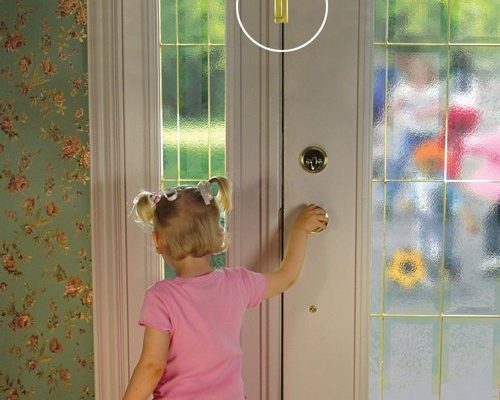
Here’s the thing: childproofing exterior door locks isn’t just about buying a gadget or two. It’s about finding the right balance between security, practicality, and everyday convenience. Some parents swear by complex coded locks from brands like Schlage or Kwikset, while others stick to good old-fashioned add-on latches. Either way, the goal is the same—making sure your little adventurer stays safe inside until you’re ready to head out together.
Let’s break down what actually works, what to look out for, and the smart steps to make sure your exterior door locks are kid-proof without making your own life a headache.
Why Childproofing Exterior Door Locks Matters
Let me explain why this step gets skipped or underestimated, even by seasoned parents. Most people picture their kids scaling baby gates or rummaging through cabinets, but the front or back door often gets less attention. Yet, once your child can reach the handle and start fiddling, your sense of security changes fast. A quick dash outside, especially near a street or yard, can happen in seconds.
Honestly, exterior doors have an extra layer of risk compared to interior ones. Sure, there’s the fear of wandering, but also the worry of kids letting strangers in—or slipping out when you’re not looking. A simple deadbolt doesn’t always cut it. Many models are easy to unlock once a child figures out the trick, or if the key is still in the lock.
Childproofing isn’t just about buying any product off the shelf. You need something that actually fits your specific door, works with your lifestyle, and keeps things convenient for adults. It isn’t one-size-fits-all; it’s about picking the right strategy for your family, your home, and your peace of mind.
Types of Childproof Door Locks and Add-Ons
When it comes to childproofing exterior door locks, the options are surprisingly broad. You don’t have to gut and replace your entire lock—there are plenty of add-ons and workarounds that work with most major brands. The trick is knowing which kind makes sense for your family.
- Top-of-door latch: These sit high above regular reach (unless your kid is part giraffe) and are basically invisible to small children. They’re easy for adults, tough for little hands—just remember to install them properly.
- Deadbolt covers: If your lock is the twist-and-turn variety, a sturdy cover keeps it from spinning until you really need it. Not all brands fit every deadbolt, so check compatibility before you buy.
- Keyless coded deadbolts: Schlage and Kwikset both offer models with simple, programmable codes. You can keep the passcode a mystery—or choose a combination only adults know. These are great if you lose keys but want to avoid spare keys lying around.
- Sliding door locks: If you have patio or deck doors, special sliding door locks add an extra layer above the reach of little ones. Some versions even require two simultaneous actions, which is a puzzle for young kids.
Picking the right lock or add-on isn’t just about the mechanism; think about how easy it’ll be to use in an emergency. If you need to get outside quickly, you want something foolproof for you and tricky for everyone else.
Installing Childproof Locks: Steps and Tips
Let’s walk through installation—the part where most people get tripped up. Even the best lock in the world is useless if it’s installed wrong or not fully engaged. The instructions that come in the box? Sometimes they’re more confusing than helpful.
Start with a clean door surface. Dirt, old adhesive, or grime can keep a latch or cover from sticking. If you’re using screws, double-check what’s behind your drilling spot so you don’t mess up the doorframe.
Measure twice, install once. Take a moment to check the height and see if your kid can reach. I know, it seems obvious, but you’d be surprised how fast kids grow—or how tall they can get with a chair.
Test the lock’s action. Before you trust the new lock, try opening the door yourself, both in a hurry and slowly. See if you can operate it one-handed (think: arms full of groceries). If it jams, adjust the placement before calling it done.
Don’t forget to show everyone in the house how it works. There’s nothing worse than locking yourself out because your partner or babysitter didn’t know about the new “trick” to unlock the door.
Balancing Security and Everyday Convenience
You might be wondering if there’s a point when childproofing just makes everyday life harder. There is—but there are ways to avoid it. Strong security should never come at the cost of your own comfort or safety.
Consider emergency exits. Any lock you install needs to be quick for adults to open, even in the dark or in a rush. I’ve seen setups where the adult fumbles with a tricky latch and precious seconds tick by—nobody wants that during a real emergency.
Routine checks help. Over time, kids get smarter (sometimes at an alarming rate). What worked last week might not stop them after some trial and error. Make a habit of reviewing your system every few months, or whenever you notice your child eyeing up the door like a puzzle.
Don’t rely on one solution. Redundancy can be your friend here. For example, a high latch paired with a coded lock provides two layers: one physical, one mental. If your child figures out one, you’ve got a backup.
Balancing convenience and safety means adjusting as your child grows and as daily life changes—there’s no shame in tweaking or upgrading over time.
Addressing Common Problems and Mistakes
Here’s where most parents (myself included) run into speed bumps. Sometimes the best intentions create new hassles, and it’s easy to make mistakes when you’re rushing through setup.
- Using tape or weak adhesive: Child-strength isn’t the same as adult-strength. A busy toddler determined to get out can peel off low-quality or worn adhesive in minutes.
- Forgetting about guests or other adults: It’s easy to forget to explain new locks to grandparents, friends, or sitters. Leave a note, or better yet, give a quick demo.
- Ignoring maintenance: Locks and latches wear out over time. Check for loose screws, worn batteries (if electronic), or sticky mechanisms that slow you down.
- Overcomplicating: Sometimes, a simple solution works best. Don’t layer on so many locks that getting out feels like an escape room. Find the sweet spot where your kids are safe, but you’re not annoyed every time you leave or come home.
Every home is a little different. The door material, the way it sits in the frame, or even the climate can change how locks behave. Don’t be afraid to try a few options before you settle on what works.
Choosing the Right Lock: Universal vs Brand-Specific Options
Picking between a universal childproof lock and one made for your specific brand (like Schlage or Kwikset) can be confusing. Honestly, both have their place, but there are clear pros and cons.
- Universal add-ons: They’re often cheaper and fit a broader range of doors. The downside? Fit isn’t always perfect, and sometimes you’ll need to tweak or reinforce to get solid security. But for rentals—or if you’re not ready to replace the lock entirely—they’re a smart start.
- Brand-specific upgrades: Companies like Schlage or Kwikset often design high-end deadbolts and coded locks with built-in child-resistant features. These fit seamlessly, look sleek, and may be easier to install if you’re already using that brand. They’ll often integrate with smart home systems, letting you pair remotes or sync codes for added convenience.
Think about your long-term needs. If you’re planning to stay in your home, a brand-specific lock is often worth the investment. If you move a lot or just want to try something, universal add-ons do the trick without much commitment.
Keeping Your Locks Effective As Kids Grow
Children are little problem solvers—what stumps them at age two might be old news a few months later. That means childproofing is not a set-it-and-forget-it job.
Update your approach regularly. As your child’s skills change, so should your locks. What works for a toddler won’t always fool a preschooler, and trust me—once they start watching how you unlock it, they’ll start imitating you. Mix up lock types, move latches higher, or switch to more complex keyed or coded systems as needed.
Talk to your child about safety. Beyond mechanical solutions, start explaining why you have locks in place, even in simple terms. Kids can be surprisingly receptive when you talk honestly about safety and “grown-up” rules.
Consider technology upgrades. As your kids get older and more independent, you may shift toward more sophisticated locks—think touchpads, smart locks, or systems you can control with your phone. These allow you to reset, sync, or pair new codes without swapping out hardware every year.
For parents, no lock is a substitute for supervision, but good childproofing gives you extra peace of mind and time to react—when life inevitably gets a little chaotic.
Final Tips For Stress-Free Childproofing
Childproofing exterior door locks isn’t about creating a fortress. It’s about being smart, staying one step ahead of your kids, and keeping daily life simple for adults. The best solutions are the ones that work for *your* family, fit *your* doors, and can adapt as your kids grow.
If you hit snags, don’t hesitate to consult a locksmith or check the manufacturer’s site for troubleshooting guides. Brands like Schlage and Kwikset often have online videos and support that can help if you’re stuck installing, need to reset a code, or want advice on pairing remotes or syncing new security features.
Ultimately, it’s about layering up your peace of mind without making your own life harder. The more proactive you are, the more confident you’ll feel—whether you’re running to answer the door, catch a delivery, or just enjoying a moment while your child plays safely inside.
